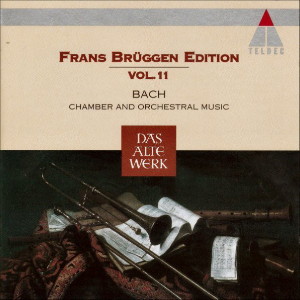 |
|
1 CD -
4509-97473-2 - (c) 1995
|
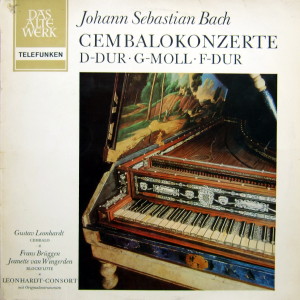
|
| 1 LP -
SAWT 9411-B - (p) 1968 |
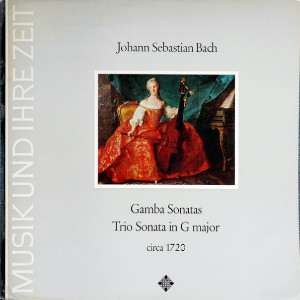 |
| 1 LP -
SAWT 9536-A - (p) 1969 |
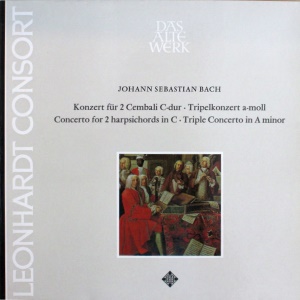 |
| 1 LP -
SAWT 9552-B - (p) 1969 |
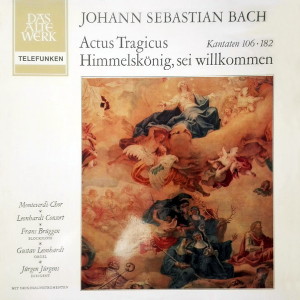 |
| 1 LP -
SAWT 9443-B - (p) 1963 |
|
| FRANS
BRÜGGEN EDITION - Volume 11 |
|
|
|
|
|
| Johann Sebastian
Bach (1685-1750) |
|
|
|
|
|
| Concerto in F
major BWV 1057 - harpsichord,
two recorders, violins, viola and
basso continuo |
16' 06" |
|
| 1.
Allegro |
6'
55" |
|
2.
Andante
|
4'
07" |
|
| 3.
Allegro assai |
5'
04" |
|
| Trio Sonata in G
major BWV 1039 - two
transverse flutes [flûtes
traversières] and basso continuo |
12' 56" |
|
4.
Adagio
|
3'
35" |
|
| 5.
Allegro ma non presto |
3'
48" |
|
6.
Adagio e piano
|
2'
27" |
|
| 7.
Presto |
3'
06" |
|
Concerto
in A minor BWV 1044 -
transverse flute, violin,
harpsichord, violins, viola and
basso continuo
|
22' 06" |
|
| 8. Allegro
|
8'
48" |
|
9. Adagio ma non tanto e
dolce
|
5'
44" |
|
10. Alla breve
|
7'
24" |
|
| Sonatina (from: Cantata BWV 106 "Gottes
Zeit ist die allerbeste Zeit"
- two treble
recorders, viols
and basso
continuo |
2'
43" |
|
11. Molto adagio
|
2'
43" |
|
| Sonata Concerto
(from: Cantata BWV 182 "Himmelskönig sei
willkommen" - treble recorder,
solo violin, strings and basso continuo |
2' 04" |
|
12. Grave. Adagio
|
2'
04" |
|
|
|
|
Frans Brüggen, recorder
(1-3, 11-12), transverse flute (4-7, 8-10)
|
The instruments |
|
Gustav Leonhardt, Harpsichord
(1-3, 8-10), organ (11-12)
|
recorders |
|
| Jeanette van Wingerden,
recorder (1-3, 11) |
- Conrad Fehr, Zurich
1961 treble [alto] in f' - [11-12] |
|
Marie Leonhardt, violin
(1-3, 8-10, 12)
|
- Arnold Dolmetsch,
Haslemere 1962 treble in f' - [12] |
|
Antoinette van den
Hombergh, violin (1-3)
|
transverse flutes
|
|
| Lodewijk de Boer, viola
(1-3) |
- A. Grenser, Dresden
1750 - [4-7] |
|
| Dijck Koster, viola
(1-3) |
- Friedrich von Heune
(after Hotteterre), Boston - [4-10]
|
|
| Fred Nijenhuis, double
bass (1-3) |
violins |
|
| Leopold Stastny, transverse
flute (4-7) |
- Jacobus Stainer,
Absam 1676 - [1-3] |
|
Nikolaus Harnoncourt, violoncello
(4-7)
|
- Klotz, Mittenwald
18th century - [1-3] |
|
| Herbert Tachezi, harpsichord
(4-7) |
viola |
|
Heinrich
Haferland, viol
(11)
|
- Giovanni Tononi, 17th
century - [1-3]
|
|
| Veronika
Hampe, viol
(11) |
violoncello |
|
|
- Giovanni Battista
(II) Guadagnini, 1749 - [1-3]
|
|
|
viols |
|
|
- after Tielke, Hamburg
1673 - [11]
|
|
|
- Hendrik Jacobsz,
Amsterdam c. 1680 - [11] |
|
|
double bass |
|
|
- German 19th century -
[1-3] |
|
|
harpsichords |
|
|
- Rainer Schütze,
Heidelberg - [1-3] |
|
|
- Martin Skowroneck,
Bremen - [4-7] |
|
|
- Martin Skowroneck
(after J. D. Dulcken), Bremen 1962 - [8-10] |
|
|
organ |
|
|
- Klaus Becker,
Kupfermühle 1961 - [11] |
|
|
|
|
|
Luogo
e data di registrazione |
|
-
Vienna (Austria) - marzo &
aprile 1968 [4-7]
- Bennebroek (Olanda) - dicembre
1967 [8-10]
|
|
|
Registrazione:
live / studio |
|
studio |
|
|
Producer /
Engineer |
|
Wolf
Erichson [4-7, 8-10]
|
|
|
Prima Edizione
LP |
|
-
Telefunken "Das Alte Werk" - SAWT
9411-B - (1 LP) - durata 45' 13" -
(p) 1968 - Analogico [1-3]
- Telefunken "Das Alte Werk" -
SAWT 9536-A - (1 LP) - durata 42'
17" - (p) 1969 - Analogico [4-7]
- Telefunken "Das Alte Werk" -
SAWT 9552-B - (1 LP) - durata 40'
31" - (p) 1969 - Analogico [8-10]
- Telefunken "Das Alte Werk" -
SAWT 9443-B - (1 LP) - durata 49'
45" - (p) 1963 - Analogico [11-12]
|
|
|
Edizione CD |
|
Teldec
- 4509-97473-2 - (1 CD) - durata
56' 18" - (c) 1995 - ADD |
|
|
Note |
|
- |
|
|
|
|
Many of Bach’s
works are impossible to date
with any accuracy but are
attributed to a particular period
on the basis of speculation
and stylistic criteria. This
already complex situation is
further complicated by the
fact that Bach frequently
revised his works and
rewrote them for other
forces. The Harpsichord
Concerto in F major BWV
1057, for example, is not an
original work but started
life as the fourth
Brandenburg Concerto BWV
1049. Like his other
harpsichord concertos (BWV
1052-8),
Bach wrote it for the
Leipzig concerts that he
gave at Zimmermann's
coffee-house with the local
Collegium musicum, an
instrumental ensemble made
up of professional musicians
and students. The Trio
Sonata in G major BWV 1039
likewise survives in an
alternative version for
viola da gamba and
harpsichord (BWV 1027) that
may have been written at
Cothen in 1720.
It is
generally believed that
Bach’s so-called Triple
Concerto BWV 1044 of around
1738-40
was similarly written for
the Collegium musicum and
that it represents a formal
return to the world of the
concerto that Bach had first
explored in his fifth
Brandenburg Concerto. The
Triple Concerto itself
derives from earlier works:
the first and third
movements are revisions of
the Prelude and Fugue for
organ BWV 894, while the
second movement is a
relatively minor reworking
of the middle movement of
the Trio Sonata for organ
BWV 527. It is unclear
however whether the two
movernenm of the Prelude and
Fugue BWV 894 represent the
original form of the
concerto's outer movements
or whether these latter were
not in fact initially based
on a lost harpsichord
concerto. If
that is so, the Triple
Concerto could well have
been written during Bach`s
years in Cöthen. The
triplet writing in the
opening movement recalls the
final Allegro assai of the
Violin Concerto in A minor
BWV 1041, which we know was
composed in Cöthen.
But whereas the latter is
dominated from beginning to
end by the triplet rhythm,
the triplets in BWV 1044 are
offset, on the one hand, by
a vigorous, wavelike
sequence of rising
semiquavers and, on the
other by a series of
syncopations. In
the second movement (as in
the fifth Brandenburg
Concerto) the ripieno
strings fall silent, while
the three soloists vie with
each other on equal terms.
The third movement gives
prominence to the
harpsichord, which is even
allowed a brief cadenza,
while the writing for
recorder and violin,
although independent,
scarcely demands any great
display of bravura
virtuosity on their part.
The cantata Gottes Zeit
ist die allerbeste Zeit
BWV 106 (also known as the Actus
tragicus) is scored
for minimal resources: three
vocal soloists, chorus, two
recorders, two violas da
gamba and basso continuo.
The vocal movements are
introduced by a brief
instrumental movement or
“sonatina”. The
instrumentation of the
piece, which was probably
written for a funeral,
illustrates the
tone-painting characteristic
of the period, with the
recorders symbolising the
celestial heights, the
violas da gamba the whole of
suffering creation. With its
French-style dotted rhythms,
the “Sonata concerto”
provides the instrumental
introduction to a cantata
that Bach wrote in Weimar in
1714.
Martin
Elste
·····
A brief
history of the
recorder
11.
The recorder in the
20th century
Frans Brüggen
(I)
Frans Brüggen
was born in Amsterdam in
1934 as the youngest of nine
children. He first came into
contact with the recorder
during the Second World War,
when schools were closed. He
received his first lessons
from his brother Hans, who
was studying law and who
also played the oboe. His
first official teacher was
Kees Otten, with whom he
studied both privately and,
at the Amsterdam
Muzieklyceum,
professionally. He graduated
in 1954, as one of the first
students to complete a
degree course in the
recorder as a principal
instrument, such courses
only recently having been
introduced to the
Netherlands. At this time he
was also studying musicology
at the University of
Amsterdam and the modern
flute. He joined the
Amsterdams Blokfluit
Ensemble, a group of four
players led by Kees Otten.
As a soloist, Brüggen
needed not only sufficient
interesting music but also
decent instruments. In
the mid-1950s
he spent some time in
Innsbruck and also scoured
Austrian and italian
libraries and museums in his
search for suitable material
and instruments. On his
return to the Netherlands he
was
introduced by Kees Otten to
Gustav Leonhardt, who had
similarly just returned to
Amsterdam after a period of
study in Basle and teaching
commitments in Vienna. It
was a decisive encounter,
leading to a collaboration
that was to last several
decades.
In
1959 Brüggen
became professor of recorder
and early music at the
Amsterdam Muzieklyceum and
at the Royal Conservatory
The Hague, positions he
retained until the early
1970s. Although lacking an
immediate role model, Brüggen
became the first recorder
player to combine artistic
intelligence with immaculate
technique. And, in essence,
he was the first genuine
recorder soloist of the 20th
century since the recorder
had hitherto been the second
instrument of oboists,
flautists and others. Brüggen
gave the recorder a rightful
place on all the worlds
great concert platforms. His
activities as a recorder
player coincided with a
period when early music was
still finding its way into
modern concert halls. Also
at this time he became
involved with writers,
composers and visual artists
such as Reinbert de Leeuw,
Louis Andriessen, Peter
Schat, ]an van Vlijmen,
Harry Mulisch and Misha
Mengelberg, with whom he
collaborated on the opera Reconstructie
in 1969. At that time there
was still no world of early
music, and even later Brüggen
preferred to keep his
distance from such a world,
emphasising innovation
rather than conservation.
One result of this has been
that Brüggen
has persuaded many composers
to write new works for him.
Among the composers who have
dedicated solo works to Brüggen
are Luciano Berio, Louis
Andriessen, Peter Schat,
Makoto Shinohara and Maki
Ishii. No less typical was
his involvement in
musico-political
demonstrations at the end of
the 1960s, when he took part
in demonstrations against
the Vietnam War and
protested on behalf of
composers.
In 1962 he began recording
for TELDEC’s series “Das
Alte Werk”. Even his
earliest releases - recorder
sonatas by Telemann and
Handel with Gustav Leonhardt
and Anner Bylsma - were
enthusiastically received
and honoured with many
international awards.
In
the meantime, the Utrecht
recorder maker Hans Coolsma
had developed a new solo
recorder at Brüggen's
instigation that was
considerably more
sophisticated than all the
other models then available.
Until the mid-sixties
all efforts had been
directed at performing early
music in as stylistically
faithful a manner as
possible, a fidelity sought
by consulting contemporary
writings, manuscripts and
other sources. What was new
after the mid-sixties was
the conviction that
instruments from the period
when the works themselves
had been written and, hence,
appropriate to their style,
were necessary to realise
the composers ideas and
feelings as authentically as
possible.
In
1962 Gustav Leonhardt
invited the Bremen
instrument maker Martin
Skowroneck to build copies
of early harpsichords, and
this in turn encouraged Brüggen
to follow up this idea by
suggesting that Skowroneck
might attempt to make copies
of early recorders. The
result of this initiative
was a descant recorder
modelled on an instrument by
Terton in the Gemeentemuseum
in The Hague and a treble
instrument copied from a
recorder by Bressan in the
private collection of Edgar
Hunt. These copies ushered
in a new era in the
performance of early music
on the recorder.
Peter
Holtslag
Translation:
Stewart Spencer
|
|